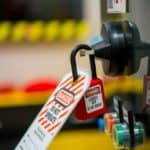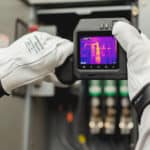Electrical workers such as machine operators, maintenance technicians, and electrical contractors are no strangers to working with energized assets. Day-to-day they run a huge risk in managing and maintaining these assets and we’re not just talking about electric shock or electrocution.
In facilities where large amounts of energy flow, there is potential for an arc flash to occur, wherein just one second, the air and all the surrounding areas are heated up to a temperature that is equivalent to the sun’s surface.
Workers in the area of an arc flash can face serious to fatal injuries, which is why it’s important to have the equipment and practices in place to prevent these incidents from happening.
We’ve discussed serious and fatal injury prevention in previous posts, but haven’t touched on the critical need for having the right equipment to mitigate these situations. In this post, we discuss why having an arc flash relay in your switchgear can not only be a lifesaver, but can also protect your assets and save on costs.
The Importance of Arc Flash Relays
Arc flashes cause power outages and equipment and property damage, which can jeopardize the safety of your electrical workers and lead to production and financial loss. Should an arc flash occur, it’s important to have arc flash protection, specifically an arc flash relay in your facility’s switchgear because it will trip the circuit breaker and cut off the current feeding the arc flash.
There are many arc flash relays available in the market that it can be overwhelming to search for and install the right option. SEAM Group’s arc flash relay, as an example, is configured based on the SEL-751 protection relay, where the arc flash function is based on monitoring system current as well as light via fiber optic cables installed in the equipment.
What makes this arc flash relay the best on the market is that it is capable of also monitoring voltage and data logs and provides other system protection like under voltage and ground fault.
Because the relay is always active and monitoring the system for an arc flash, a facility does not have to rely on someone activating the system before doing work, which removes the potential for human error.
Arc flash relays provides the following benefits:
- Equipment protection on the load side during an event
- Reduced downline incident energy
- Decreased equipment downtime
- Arc flash incident prevention
Work With SEAM Group to Prevent Arc Flash Incidents
Just about any site that has a direct utility feed will have a need for an arc flash relay if they are interested in reducing the hazard on the load side of the main protective device in the equipment. But before your facility inquires about arc flash relay installations alone, work with a partner like SEAM Group to conduct an Arc Flash Hazard Assessment.
With the assessment, SEAM Group assesses your current state, helps your organization uncover issues in your electrical distribution system that may be hidden underneath the surface, and makes recommendations for reducing incident energy.
If there are any issues with your equipment, SEAM Group works with your organization to correct and repair them, installing new equipment such as arc flash relays where needed, providing monitoring and maintenance to ensure assets are working as they should, and offering training for your electrical team to manage energized assets safely.
An arc flash relay is critical to have in your electrical gear, but knowing what other problems your system may have and correcting them proactively and routinely can only extend the lifecycle of your assets and improve your operational and safety performance in the long term.
Connect with SEAM Group for arc flash protection and learn how to prevent electrical incidents, maintain compliance with NFPA 70E and other regulations, and save on operational costs.





